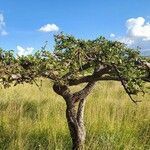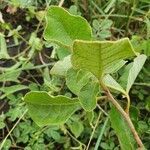Deciduous shrub or small tree 2–5 m. high; crown spreading; bark rough, brownish grey.. Leaves usually trifoliolate, very rarely 1-foliolate or 5-foliolate, often crowded on short node-like branchlets; petiole up to 6 cm. long; terminal leaflet obovate, 1–6.5 cm. long, 1–7.2 cm. broad, on a petiolule up to 2 mm. long or sessile; lateral leaflets usually smaller and mostly sessile, obovate, ovate or elliptic, obtuse and sometimes retuse at the apex, cuneate or obtuse to somewhat truncate at the base, discolorous, margin entire or undulate, young ones densely floccose-stellate-tomentose on both surfaces, upper surface later with sparse stellate and simple hairs, the lower surface remaining whitish densely tomentose with both stellate and simple hairs; midrib and lateral nerves prominent beneath.. Inflorescences of spike-like panicles 1–3 cm. long, clustered on short lateral branchlets; axis densely whitish tomentose.. Flowers clustered on the peduncle, subsessile or with pedicels up to 6 mm. long.. Calyx-lobes ovate, 1–1.5 m. long and broad, tomentose.. Petals elliptic-obovate, 2.5–3(–3.8) mm. long, 1.5–2 mm. broad, greenish yellow, unguiculate; ovary rudimentary in ♂, 4-locular in ♀, 1 mm. long, densely tomentose; styles 4, glabrous and with peltate stigmas.. Drupe ovoid, 6–9 mm. long, 5–8 mm. in diameter, somewhat longitudinally ridged, apex with (3–)4 horns showing remains of the original 4 styles, densely stellate-tomentose.
More
A shrub or small tree. It is spreading. It grows about 5 m high. The bark is smooth and dark grey. The branches are flexible. The leaves are divided into 3 leaflets. The flowers are in spikes and are cream coloured. The fruit are a dull green. They have soft hairs. The seeds are red.




